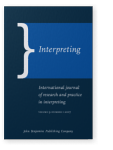Inge Gorm Hansen
List of John Benjamins publications for which Inge Gorm Hansen plays a role.
2015 Sound effects in translation Interdisciplinarity in Translation and Interpreting Process Research, Ehrensberger-Dow, Maureen, Susanne Göpferich and Sharon O'Brien (eds.), pp. 141–155 | Article
On the basis of a pilot study using speech recognition (SR) software, this chapter attempts to illustrate the benefits of adopting an interdisciplinary approach in translator training. It shows how the collaboration between phoneticians, translators and interpreters can (1) advance research, (2)… read more
2013 Sound effects in translation Interdisciplinarity in Translation and Interpreting Process Research, Ehrensberger-Dow, Maureen, Susanne Göpferich and Sharon O'Brien (eds.), pp. 140–154 | Article
On the basis of a pilot study using speech recognition (SR) software, this paper attempts to illustrate the benefits of adopting an interdisciplinary approach in translator training. It shows how the collaboration between phoneticians, translators and interpreters can (1) advance research, (2)… read more
2011 Time lag in translation and interpreting: A methodological exploration Methods and Strategies of Process Research: Integrative approaches in Translation Studies, Alvstad, Cecilia, Adelina Hild and Elisabet Tiselius (eds.), pp. 121–146 | Article
Time lag between the source text input and the interpreter’s target text is known as ear-voice span or décalage. Recently, time lag has also been measured in written translation based on eye-tracking and key-logging (hence called eye-key span). Time lag provides insight into the temporal… read more
2007 The silver lining: Technology and self-study in the interpreting classroom Interpreting 9:1, pp. 95–118 | Article
In an attempt to offset the negative effects of reduced contact hours, teachers of interpreting are encouraged to take advantage of cost-effective methods, including technology-assisted self-study sessions and offline practice. This paper describes the use of new pedagogical tools and equipment… read more



